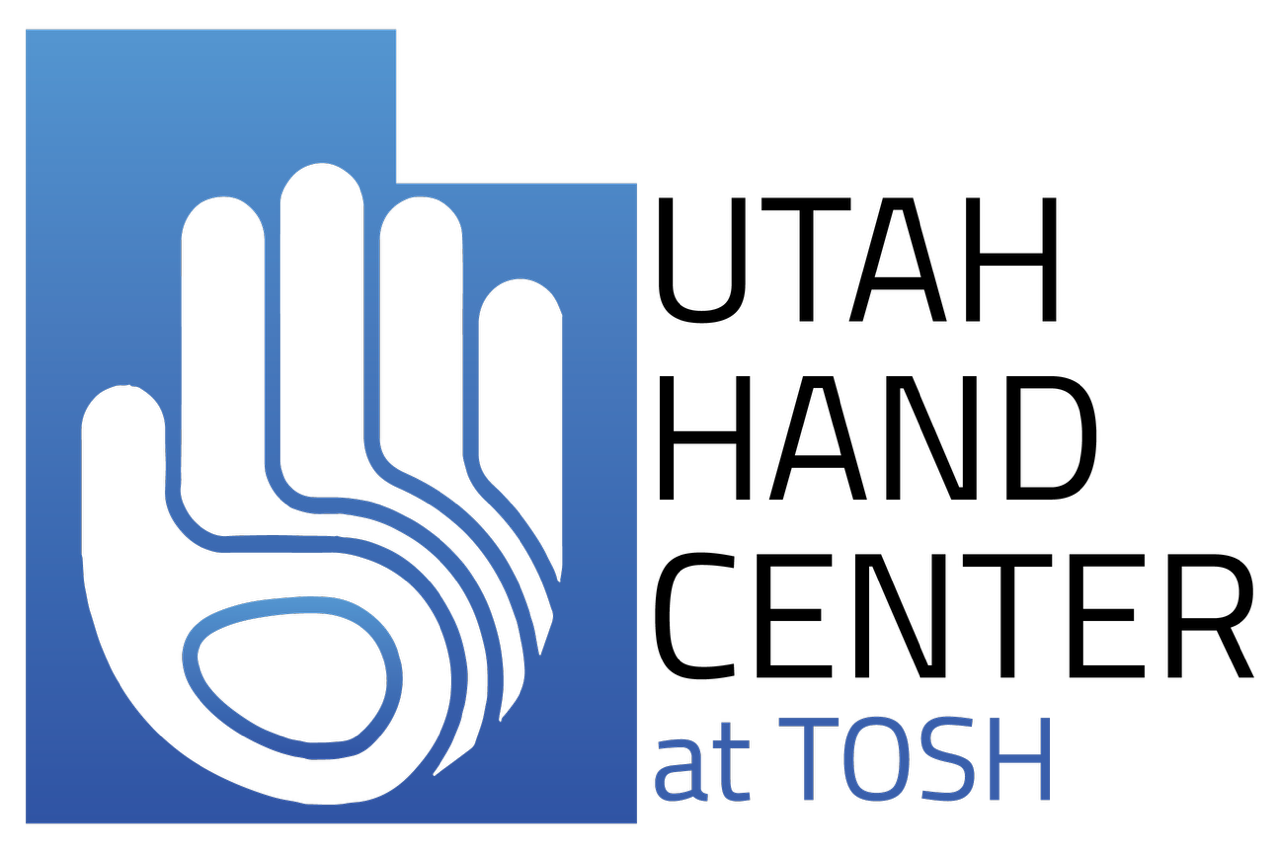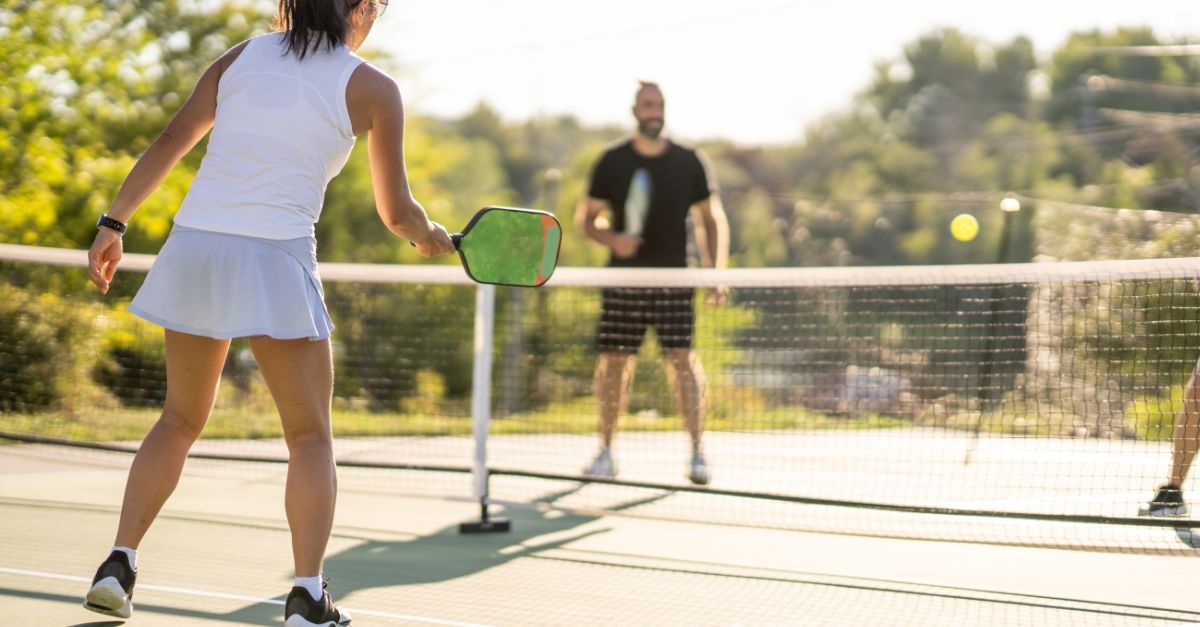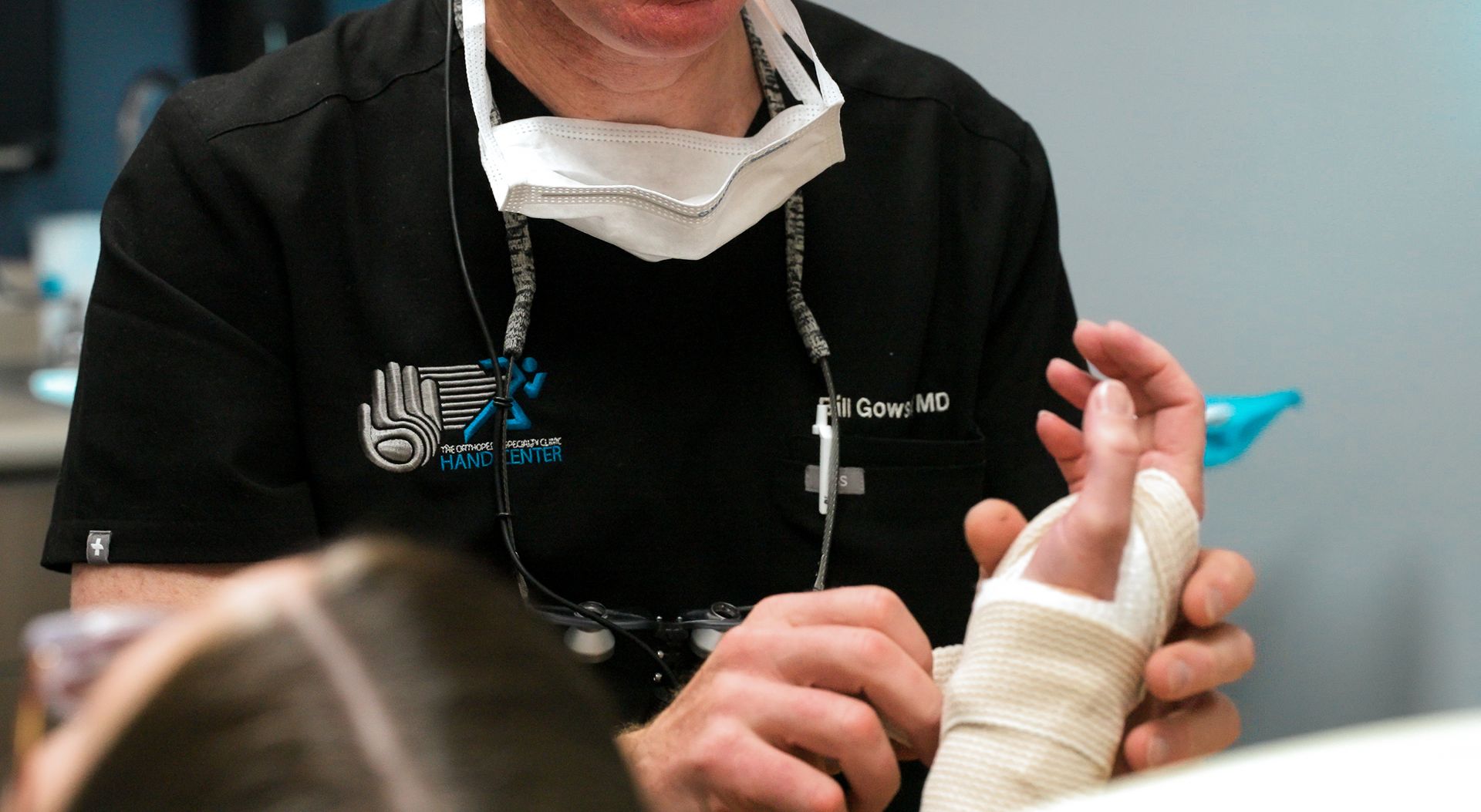HAND & WRIST

Utah Hand Center at TOSH
Hands are our interface with the world. As a result, hand injuries are common, and can drastically affect day-to-day life. Function of the hand is dependent on precise interaction of the many bones, tendons, nerves, and blood vessels that compromise the human hand. These structures allow us to care for our children, complete a day’s work, or enjoy our pastimes and passions.


Our physicians specialize in advanced hand and wrist treatment. They have all received additional fellowship instruction in the care of these specialized, and critical structures. Commonly treated hand and wrist conditions are:
- Carpal tunnel syndrome/Cubital tunnel syndrome
- Trigger finger
- Hand and wrist arthritis
- Tendon injuries
- Nerve Injuries
- Fractures of the upper extremity
- Hand and Finger deformities
- Elbow and wrist instability
- Hand and wrist masses/cysts
Many upper extremity ailments including carpal tunnel, trigger finger, and hand arthritis can be treated with wide awake surgery. These procedures are performed in our office under local anesthesia. Performing many procedures in this manner allows quicker recovery as well as decreased procedural risk. In many conditions, wide awake surgery can be performed at lower cost, without compromising results. Our experienced physicians treat a variety of upper extremity ailments in this manner. For patients with non-participating insurance plans, discounted cash rates are available for these procedures.
Procedures
WRIST JOINT REPLACEMENT
Wrist joint replacement surgery, also referred to as total wrist arthroplasty, involves the replacement of a severe arthritic wrist joint with an artificial joint made of metal and plastic components. It relieves pain and restores function when conservative treatment fails to provide relief.
CARPAL TUNNEL RELEASE SURGERY
Carpal tunnel syndrome can be treated with carpal tunnel release surgery. Traditional surgery involves an incision of up to 2 inches in the palm and wrist area, whereas endoscopic surgery involves one or two half-an-inch incisions and the use of an endoscope.
ENDOSCOPIC CARPAL TUNNEL SURGERY
The carpal tunnel is a narrow passageway on the palm side of your wrist. Small wrist bones known as carpals form the bottom and sides of the carpal tunnel and a strong band of connecting tissue, known as the transverse carpal ligament, covers the top of the carpal tunnel.
HAND FRACTURE SURGERY
The hand is one of the most flexible and useful parts of our body. Because of overuse in various activities, the hands are more prone to injuries, such as sprains and strains, fractures and dislocations, lacerations and amputations while operating machinery, bracing against a fall and sports-related injuries.
PERIPHERAL NERVE REPAIR
The peripheral nerves are the nerve fibers that compose the area from head to toe, connecting the brain and spinal cord with the rest of the body parts. Nerves transmit electrical impulses and signals to and from the brain.
WRIST ARTHROSCOPY
Wrist arthroscopy is a minimally invasive surgical procedure performed to view, diagnose and treat problems of your wrist joint.
WRIST FRACTURE FIXATION
When the fractured ends are significantly displaced, surgery is necessary for wrist fracture fixation. Surgical treatment options include open reduction and internal fixation (ORIF) which involves the use of pins, plates, and screws to properly align the fractured ends and stabilize the fracture from the inside.
WRIST LIGAMENT RECONSTRUCTION
Surgical treatment in the form of wrist ligament reconstruction may be indicated in cases where the wrist ligament is completely torn. The ligament will usually need to be reconstructed when ligament damage is noted after a period of 6 months or more after the initial injury.
NON-SURGICAL TREATMENT OF HAND AND WRIST
The hand is one of the most flexible and useful parts of our body that enable us to perform many of our daily activities. The hands and wrists are prone to injuries or certain orthopedic conditions and can range from minor cuts or burns to severe arthritis or injuries of nerves, bones, and tendons.
ARTIFICIAL FINGER JOINT REPLACEMENT
Artificial finger joint replacement is a surgical procedure that involves the removal of an arthritic or damaged finger joint and replacement with an artificial prosthesis.
SPORTS INJURY MANAGEMENT OF HAND, WRIST AND ELBOW
Sports injuries are injuries that most commonly occur during sports and exercises. These injuries may result from accidents, poor training practices, and use of improper protective gear, lack of conditioning, and insufficient warm-up and stretching.
SURGERY FOR THUMB AND DIGIT ARTHRITIS

Arthritis is an inflammatory condition of the joints. There are several types of arthritis; the most common type is osteoarthritis or wear-and-tear arthritis that affects the joint at the base of the thumb. Thumb arthritis is more common in women than men, and usually occurs after the age of 40 years.
LRTI (LIGAMENT RECONSTRUCTION AND TENDON INTERPOSITION) FOR THUMB CMC ARTHRITIS

LRTI (ligament reconstruction and tendon interposition) is a surgical procedure that is most commonly conducted to treat thumb CMC (carpometacarpal) arthritis where the damaged joint surfaces are removed and replaced with a cushion of tissue that keeps the bones separated.
TOTAL WRIST ARTHRODESIS

Arthrodesis is the surgical immobilization of a joint by the fusion of the adjacent bones.
FINGER JOINT FUSION

Finger joint fusion is performed under local or general anesthesia and usually takes about 2 hours to complete.
ARTHROSCOPIC PARTIAL WRIST FUSION

Arthroscopic partial wrist fusion is a minimally-invasive surgery that uses tiny incisions to immobilize selected bones of the wrist.
NERVE DECOMPRESSION OF THE UPPER EXTREMITIES

Nerve decompression of the upper extremities, also called peripheral nerve decompression, is a minimally invasive surgical procedure employed to relieve pressure on an entrapped or pinched nerve (neuroma) for the treatment of conditions such as carpal tunnel syndrome and cubital tunnel syndrome, the two most common nerve compression syndromes.
DISTAL RADIOULNAR JOINT ARTHROSCOPY

The distal radioulnar joint (DRUJ) is a pivot type synovial joint located between the radius and the ulna just proximal to the wrist joint and assists in pronation and supination of the forearm.
Conditions
FRACTURES OF THE HAND AND FINGERS
A fracture is a break in the bone, which occurs when force greater than the bearable limit is applied against a bone. The most common symptoms of any fracture include severe pain, swelling, bruising or bleeding, deformity and discoloration of the skin and limited mobility of the hand.
WRIST FRACTURE
The wrist is comprised of two bones in the forearm, the radius and ulna, and eight tiny carpal bones in the palm. The bones meet to form multiple large and small joints. A wrist fracture refers to a break in one or more of these bones.
ARTHRITIS OF THE HAND AND WRIST
Arthritis is an inflammatory condition of the joints. There are several types of arthritis and the most common type is osteoarthritis or wear-and-tear arthritis. Arthritis affects various joints in the body and the arthritis in the hand affects the joint at the base of the thumb. Arthritis may also affect the joints of other digits.
ARTHRITIS OF THE THUMB
Arthritis is an inflammatory condition of the joints. There are several types of arthritis. The most common type is osteoarthritis or wear-and-tear arthritis that affects the joint at the base of the thumb. Thumb arthritis is more common in women than men, and usually occurs after the age of 40 years.
CARPAL TUNNEL SYNDROME
Carpal tunnel syndrome is a common, painful, progressive condition that is caused by compression of the median nerve at the wrist area.
WRIST INJURIES
The wrist is a commonly injured joint in the body. Problems include sprains and strains as well as fractures that can occur with lifting and carrying heavy objects, while operating machinery, bracing against a fall, or from sports-related injuries.
WRIST LIGAMENT TEAR AND INSTABILITY
A ligament is a strong, flexible band of fibrous tissue. The wrist has many ligaments that help to keep the wrist bones in proper position providing stability to the joint. A torn ligament causes the wrist bones to move out of their position, which in turn leads to wrist instability as the sprained (torn) ligament can no longer support the wrist bones.
WRIST SPRAIN
Injuries caused due to stretching or tearing of the ligaments in the wrist are called wrist sprains. Sprains can range from mild to severe, based on the extent of injury to the ligament.
FINGERTIP INJURIES
A fingertip injury is a wound or damage caused to the most distal portion of the finger. It can be a crush, a sharp cut, a tear or a combination of these, and can result in damage to the skin, nail or nailbed, tendon, pulp, bone, and nerve endings.
PEDIATRIC FOREARM FRACTURE
The radius (bone on the thumb side) and ulna (bone on the little-finger side) are the two bones of the forearm.
MALLET FINGER
A mallet finger is a condition where the end of the finger is bent and does not straighten.
FINGER SPRAIN
Injuries that involve tearing or stretching of the ligaments of your fingers are termed as sprains.
SCAPHOID FRACTURE
Scaphoid fracture occurs due to a fall on an outstretched hand with complete weight falling on the palm.
INDUSTRIAL HAND TRAUMA

The hand is one of the most flexible and useful parts of our body. Because of overuse in various activities, the hands are more prone to injuries, such as sprains and strains, fractures and dislocations, lacerations and amputations while operating machinery, bracing against a fall and during sports.
FINGER DISLOCATION

Finger dislocation is a condition in which the bone of your finger has moved away from its normal position.
BOUTONNIERE DEFORMITY

Tendons in your fingers connect the finger bones to finger muscles and help bend and straighten the finger at the joint when the muscles contract.
DUPUYTREN'S CONTRACTURE

Dupuytren’s contracture is a hand condition where thickening of the underlying fibrous tissues of the palm causes the fingers to bend inward.
TRIGGER FINGER

Inflammation in the tenosynovium leads to a condition called trigger finger, also known as stenosing tenosynovitis or flexor tendonitis, where one of the fingers or thumb of the hand is caught in a bent position.
CONGENITAL DEFECTS OF THE HAND AND WRIST

The hand and wrist are formed during the 8th week of gestation. This process consists of various steps and failure in any one or more of these steps may cause congenital or birth defects.
GAMEKEEPER'S THUMB

Gamekeeper's thumb, also known as skier's thumb, is a tear of the ulnar collateral ligament, a band of tissue that supports the joint at the base of the thumb.
SKIER'S THUMB

Skier's thumb can result from sports activities (while stopping a ball with a bare hand) or a fall on your outstretched thumb (especially while holding onto something like a ski pole).
BOXER'S FRACTURE

A boxer’s fracture is a break in the neck of the fifth metacarpal bone of the hand (below the pinky finger) close to the knuckle.
SWAN NECK DEFORMITY

The finger joint is a hinge joint that allows the bending and straightening of the fingers. Each finger is composed of 3 phalange bones joined by 2 interphalangeal joints (IP joints).
WRIST PAIN

Wrist pain is defined as any ache or discomfort in the wrist. The wrist is comprised of two bones in the forearm, the radius and ulna, and eight tiny carpal bones in the palm.
DISTAL RADIOULNAR JOINT (DRUJ) INSTABILITY

Distal radioulnar joint instability is the abnormal orientation or movement of the radius and ulna bones at the wrist in relation to one another.
WORK RELATED HAND INJURIES

The hand is one of the most flexible and useful parts of our body that assist us in most workplace activities. Hand injuries can range from minor cuts or burns to severe injuries.
METACARPOPHALANGEAL JOINT ARTHRITIS

The bones of the hand are called metacarpals and the bones of the fingers are called phalanges. The metacarpophalangeal joint or MP joint, also known as the first knuckle, is the large joint in the hand where the finger bones meet the hand bones.
MALUNION OF A FRACTURE

Malunion of a fracture is a condition where the fractured ends of a bone heal in a misaligned position resulting in bone deformity. Malunions may occur in any bone fractures in the body often due to trauma.
ENDOSCOPIC CARPAL TUNNEL RELEASE
ENDOSCOPIC CARPRAL TUNNEL RELEASE
TRIGGER FINGER RELEASE
ENDOSCOPIC CARPAL TUNNEL RELEASE


